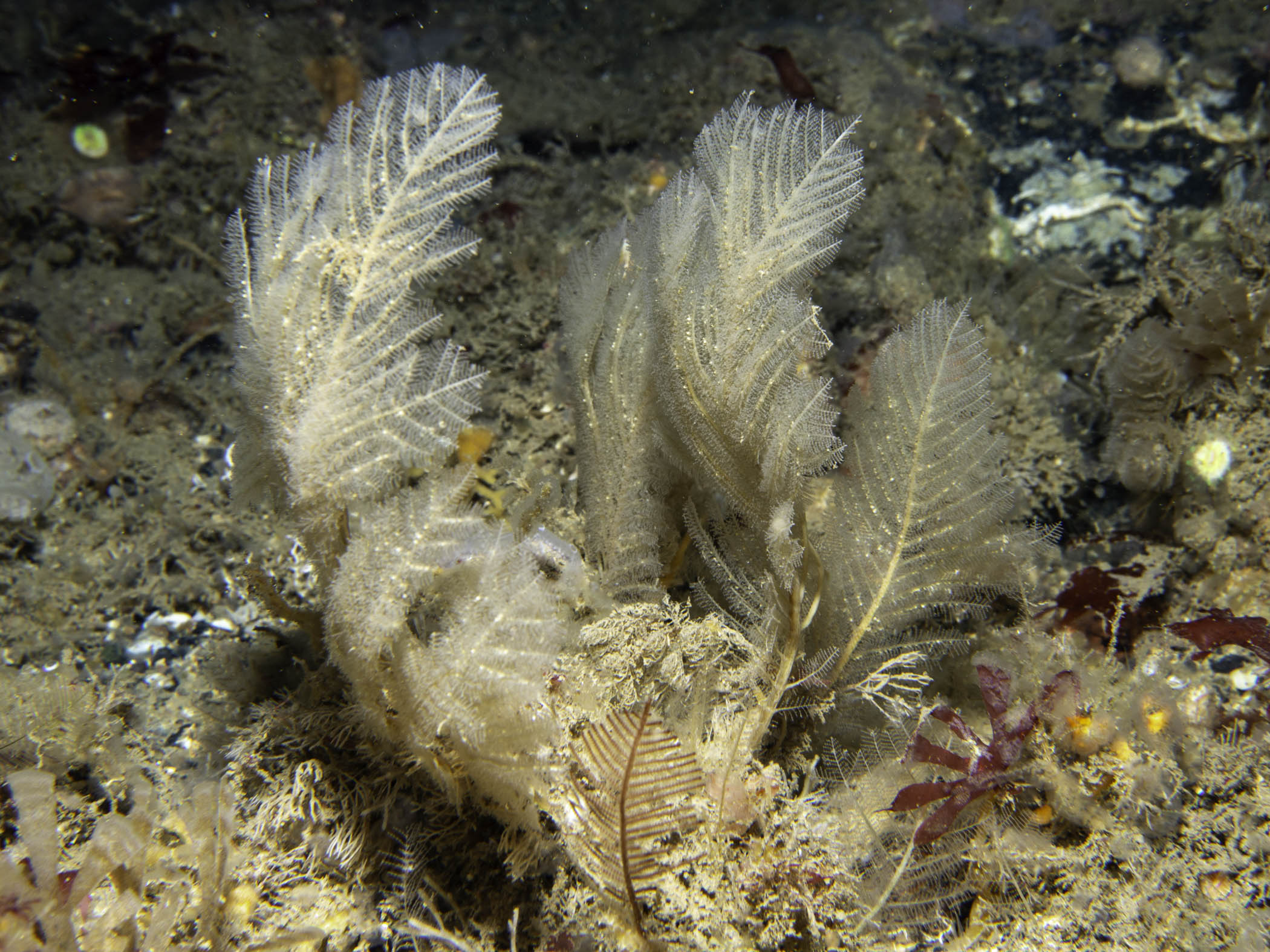Northern Ireland Priority species (NIPS)
| CNIDARIA : Leptothecata : Halopterididae | SEA ANEMONES AND HYDROIDS |
Polyplumaria flabellata Sars, 1874
 |
| Polyplumaria flabellata |
Hydroids are a group of animals which are related to sea anemones, corals and jellyfish. Most of them consist of plant-like branching colonies of small zooids, each of which has a ring of tentacles with stinging cells, surrounding a mouth. In some species the branching is very irregular and the zooids are free at the tips of the branches, whilst in other groups the branching is very regular and rather like a feather or a branch of a fir tree, with the zooids enclosed in a protein container. This species is of the latter type, with large numbers of small zooids arranged on branching, two-dimensional feather-like fronds.
In brief
- Populations of this species occur on the east coast of Rathlin Island and at the Maidens near Larne, on the Antrim coast
- In Northern Ireland this species is most abundant on low-lying rock reefs or boulders adjacent to gravel which may contain scallops
- Lives in the sea at depths of 25-1000m or more on open coasts
- Life cycle unknown, new branches probably arise yearly from a perennial base
- Scarce in Northern Ireland and almost unknown elsewhere in the UK
- Threatened primarily by bottom fishing with trawls or dredges which roll or remove the boulders.
Species description: A fan-like hydroid with irregularly branching main stems and regular side branches arising in opposite pairs from the main stem. The main stem and secondary branches bear short, regular tertiary branches. The hydrothecae are arranged on the upper edge of the tertiary branches. They are tubular in shape with a smooth outer margin, and are surrounded by four smaller, defensive polyps, one on either side, and one above and below. The gonothecae are arranged on short pedicels. They are roughly oval shaped, and have a wide aperature. The capsule tapers towards the base and is surrounded by four small, defensive polyps, located in the basal region. Typically 70mm with side branches 10mm in length.
Life cycle: Colonies produce gonothecae in early summer and presumably release planktonic larvae. No other details known.
Similar species: One similar species exists in almost the same habitat, but is more common. It is Polyplumaria frutescens (formerly Schizotricha frutescens). It differs in not having the regular, opposite, secondary branching of the colony and having longer tertiary branches bearing the polyps.
How to see this species: This is a deep water species most likely to be seen by divers visiting the seabed on the east coast of Rathlin Island or the Maidens.
Current status: Populations of this species occur on the east coast of Rathlin Island and at the Maidens near Larne, on the Antrim coast. The main stronghold for this species in Northern Ireland was the east coast of Rathlin Island where it was quite common in 30-50m depth attached to boulders on a stable gravel seabed. This area has changed considerably since 1986 and when visited in 2005 by divers and a Remote Operated Vehicle (ROV) it was found that the boulders have mostly been removed, presumably by scallop dredging activities. The hydroid is still quite frequent on bedrock reefs in the area.
Why is this species a priority in Northern Ireland?
- Decline and scarce with Northern Ireland being a stronghold consisting of over 50 per cent of the Irish population and over 20 per cent of the UK population.
Threats: The main threat to this species is scallop dredging which, since 1986, has altered the habitat where the main populations live.
Distribution Map from NBN: Polyplumaria flabellata at National Biodiversity Network mapping facility, data for UK.
iNaturalist: Polyplumaria flabellata at iNaturalist World Species Observations database.
WoRMS: Polyplumaria flabellata at World Register of Marine Species. Accepted name: Polyplumaria flabellata Sars, 1874. AphiaID: 117827.
Classification: Biota; Animalia; Cnidaria; Medusozoa; Hydrozoa; Hydroidolina; Leptothecata; Plumularioidea; Halopterididae; Polyplumaria
| Previous species | Next species |
| Authors (2024). Polyplumaria flabellata. Sars, 1874. [In] Priority species, Marine Biodiversity Portal NI. https://www2.habitas.org.uk/marbiop-ni/priorityaccounts.php?item=D6100. Accessed on 2025-04-21 |